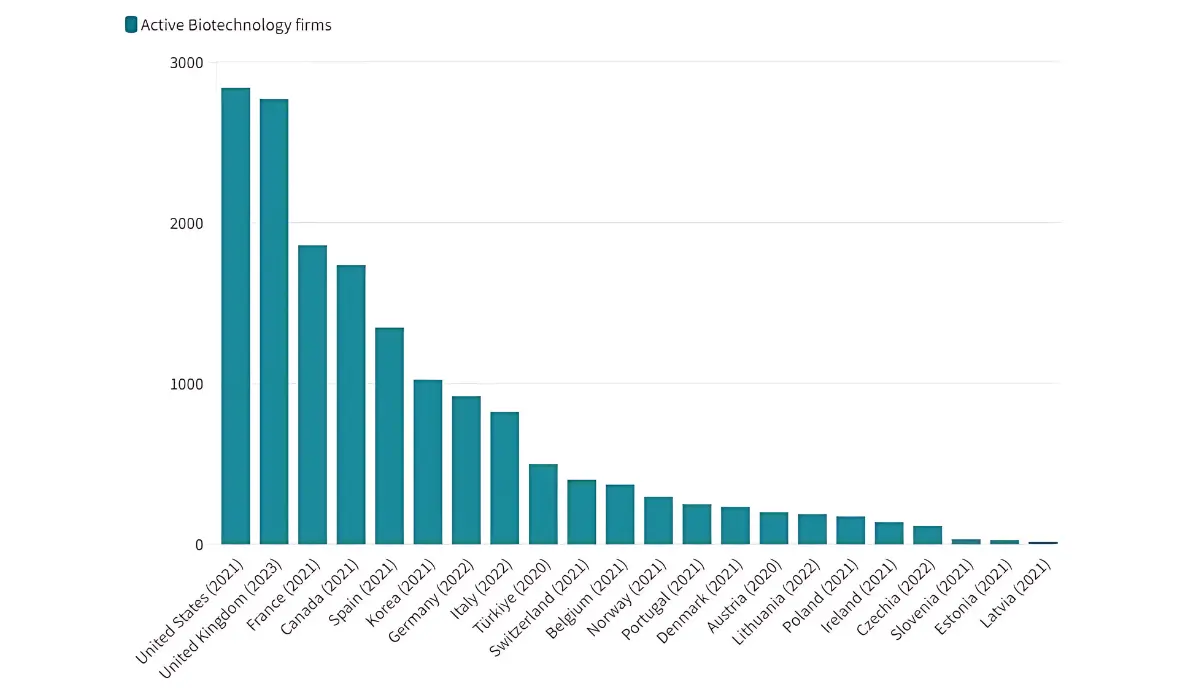Introduction: Setting the Scene
Biotechnology is a frontier discipline that embodies the future of medicine, agriculture, and sustainability. A handful of countries stand out for their strategic vision and investment in this field, ensuring their leadership status on the global stage. But how do nations compare in the race for biotech supremacy? Are there rising stars challenging traditional leaders? This report unravels these questions by delving into the dynamic landscape of biotechnology. With a curious mind and a storytelling lens, we will explore the factors driving the dominance of key biotech players while highlighting how others are catching up.
- Introduction: Setting the Scene
- The Uneven Growth Landscape
- Investing in the Future – R&D Intensity Spectrum
- Belgian Biotech Soars
- China’s Growing Influence
- France Building Momentum
- Switzerland – An R&D Leader
- The UK’s Consistent Position
- The United States – A Biotechnology Powerhouse
- Conclusion: Leaders Spearheading the Future of Biotech
The Uneven Growth Landscape
In biotechnology, the number of active companies is a key indicator of a nation’s vibrancy in the field. The Organization for Economic Co-operation and Development (OECD) recently updated its metrics to provide insights into this highly competitive landscape. The United States reigns supreme, boasting over 2,800 active biotech firms, a testament to the country’s innovation ecosystem that thrives on venture capital, elite research institutions, and a regulatory environment conducive to development. The UK follows closely, confirming its status as a major life science hub.
France and Belgium are two other European nations demonstrating solid biotech ecosystems, supported by their pharmaceutical industries and robust research cultures. Meanwhile, Canada and Spain emphasize their national policies and investments as they work toward biotech-driven economic growth and tackling health and environmental challenges. Germany’s historical strength in chemicals and pharmaceuticals naturally translates into a prominent biotech industry. However, their global standing still leaves room for expansion.
Further down the list, smaller economies like Latvia and Estonia struggle to achieve significant biotech growth. Their challenges stem from limited funding, economies of scale, and ecosystems that lack maturity. Despite these hurdles, emerging biotech nations persist, looking toward innovation-friendly policies and strategic investments.
Investing in the Future – R&D Intensity Spectrum
While active company counts hint at a nation’s biotech prowess, research and development (R&D) intensity provides a deeper understanding of strategic focus. Belgium and Switzerland stand at the forefront, each with an R&D intensity surpassing 30%. These nations recognize biotech as a growth engine and prioritize targeted policies that foster research, public-private partnerships, and tax incentives. Switzerland’s leadership in pharmaceuticals and life sciences cements its place as a global R&D powerhouse.
In the United States, R&D intensity remains over 20%, bolstered by strong governmental support, private investment, and innovation culture. Lithuania, a relatively small player, aspires to join Europe’s biotech elite by maintaining a comparable R&D intensity.
Other nations, like Canada and Spain, reflect balanced investment strategies, integrating biotech alongside other innovation pillars. Meanwhile, Austria, Latvia, and Poland trail below 5%, illustrating disparities in government support and policy focus. Their struggles underscore the importance of strategic direction and long-term funding to compete in the international arena.
Belgian Biotech Soars
Belgium’s biotech industry thrives, supported by research capabilities, favorable regulations, and collaboration. Strategic clusters, such as BioVille and the Brussels South Charleroi Biopark, are instrumental in attracting investments, creating jobs, and positioning the country as a global biotech player. However, these advances face challenges: targeted policy decisions are required to sustain growth, while a shortage of specialized talent demands STEM education reforms.
Despite fluctuations in financial performance, the sector remains optimistic. Belgian biotech firms recorded an overall increase in earnings over the last year and anticipate sustained growth in the near future. Addressing its unique strengths, Belgium’s government and industry leaders aim to remain competitive globally by embracing innovation and collaboration.
China’s Growing Influence
China’s biotechnology transformation is noteworthy, marked by a shift from generic drug production to innovation-led development. Supported by strong national policies, companies like WuXi AppTec and BeiGene have expanded their influence in the West, signaling China’s growing presence in biotech.
China’s biopharma sector shows significant strengths in manufacturing and affordable innovation, providing cost-effective alternatives to developing nations. However, talent development and basic research remain weak points. Despite these challenges, China’s government initiatives have positioned it as a pharmaceutical powerhouse.
Driven by national policies and digital advancements, China aligns with global biotech trends, prioritizing cell and gene therapies (CGTs) and monoclonal antibodies. Government agencies have encouraged innovative payment models to accelerate market access for CGTs, making China a leader in biopharma innovation.
France Building Momentum
France’s biotech industry is flourishing, particularly in Paris, a burgeoning health-technology hub. A shining example is DNA Script, which developed one of the world’s first DNA printers. This innovation mirrors the vibrant ecosystem that attracts foreign talent and gains visibility among government officials.
Globally, biotech is poised for a significant increase, driven by CGTs and strategic clusters like Paris-Saclay. French companies like Sanofi benefit from a supportive government, a culture of research excellence, and investor interest.
Despite challenges, France’s biotech sector continues to attract substantial investments, with strategic clusters driving innovation and ensuring international visibility. Supported by government backing and a vibrant ecosystem, France’s growth trajectory in healthcare, agriculture, and sustainability appears promising.
Switzerland – An R&D Leader
Switzerland’s western region is a key biotech cluster driven by world-class universities, strategic public-private partnerships, and high patent output. Investments in biotech companies tripled from 2019 to 2020, reinforcing the country’s role as a global innovation leader.
Swiss biotech clusters, such as the BioValley and Biopôle, focus on precision medicine, CRISPR/Cas9, and micro-technologies, driving progress in infectious diseases, oncology, and neurosciences. Switzerland is globally recognized for its advanced biopharma capabilities, maintaining a strategic edge through tax incentives and targeted policies.
The country’s collaborative ecosystem fosters world-leading companies and university spin-offs, bolstering innovation and growth.
The UK’s Consistent Position
The UK’s biotech sector has demonstrated impressive resilience, raising $372 million in the first quarter of 2023, even amid economic challenges. Securing significant funding in Series B and C rounds, British biotech firms attracted investor confidence and ensured sustainable growth.
Between June and August 2023, UK biotech companies secured $700 million, marking a 48% increase from the previous quarter. This steady growth and investor interest underscore the country’s leadership in venture capital.
Beyond health, engineering biology supports non-health applications like bio-based manufacturing and biofuels. The UK’s ambition to be at the forefront of sustainable innovation cements its role as a biotech leader.
The United States – A Biotechnology Powerhouse
The United States continues to lead the biotech sector, employing over 2.1 million people across 127,000 establishments. Despite economic challenges, the industry grew 11% since 2018, reflecting its resilience and central role in the COVID-19 recovery.
Mergers, acquisitions, and partnerships are common, enabling major companies to drive growth. Yet, funding remains challenging due to interest rate hikes and investor caution. However, strategic collaborations and emerging technologies like AI and regenerative medicine indicate continued sector growth.
Despite reduced IPOs and venture capital funding, the US biotech sector remains optimistic due to sustained big-pharma and biotech collaborations. Continued investment in emerging therapeutic areas supports medical breakthroughs and industry expansion.
Conclusion: Leaders Spearheading the Future of Biotech
Biotechnology’s global landscape remains uneven, with traditional leaders like the United States maintaining dominance while others, like Belgium and Switzerland, leverage strategic policies to stay competitive. Emerging players like China and France build upon their momentum with transformative research and policies, aiming to redefine global standards.
The uneven growth among biotech leaders and emerging nations opens avenues for collaboration, fostering international ecosystems conducive to solving pressing global health and environmental challenges. The dynamics and shifts explored here point to a future where biotech will be crucial in sustaining economic growth and societal well-being.





